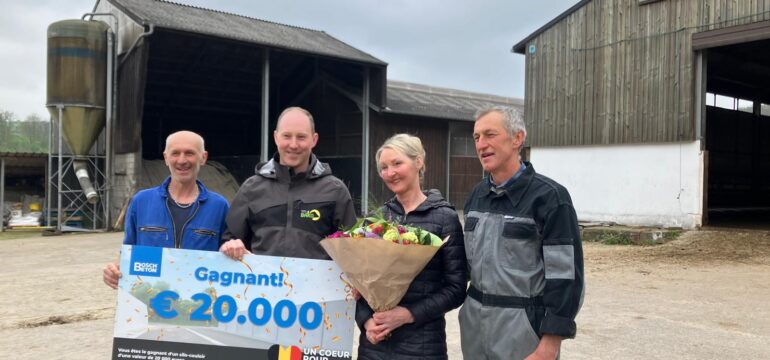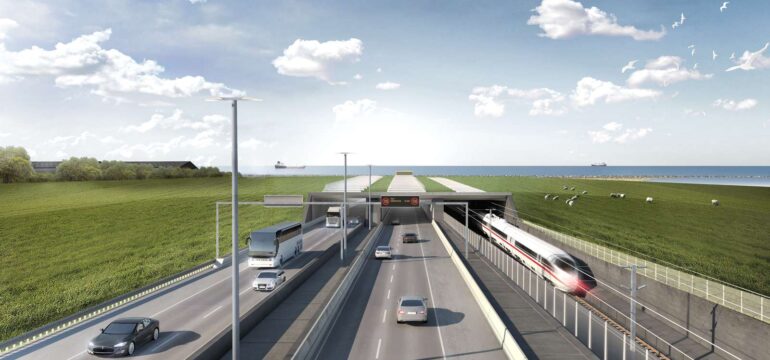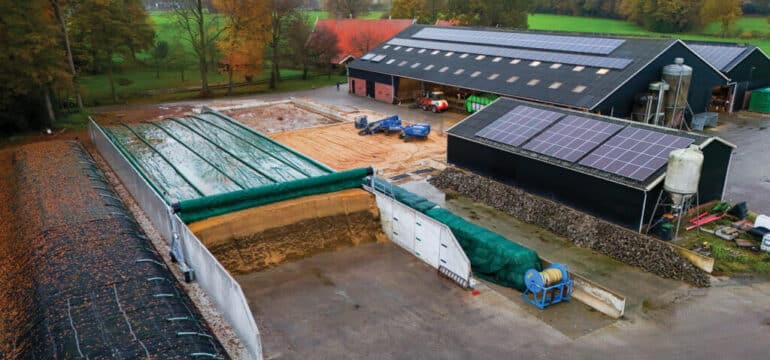
Innovation: beyond geopolymer
Bosch Beton develops and innovates. Those visiting our stand (4.5.22) at the Vakbeurs Openbare Ruimte (public space trade fair) were able to enjoy a preview of a 100% cement-free (geopolymer) retaining wall. Geopolymer is already used in products including paving stones to replace dry mortar concrete, but is not yet used in prefabricated retaining walls, where we work with self-compacting concrete.
Geopolymer retaining wall
The first prototypes have been produced, but 100% cement-free retaining walls are not yet available as further research is needed first. Although mass sales of these walls are not yet on the cards, the wall we presented at the trade fair demonstrates the possibilities. We are examining these walls from new perspectives: what should a retaining wall be capable of in terms of performance? What can take precedence over standardisation? As well as demonstrating the ECI per cubic metre, Bosch Beton also calculated the costs per linear metre including hybrid reinforcement. Higher quality enables us to build leaner and that advantage is only reflected in a price per linear metre.
Innovation
Continuous innovation and development are key to our vision and mission. The raw materials currently used, such as cement, are not only polluting, they’re also running out. We are working together on all fronts towards a sustainable production process and also want to make our concrete retaining walls 100% circular, which is why we are investigating sustainable alternatives for such raw materials as cement and clinker bricks.
Life Cycle Assessment (LCA)
In 2020, Bosch Beton was the first retaining wall supplier in the Netherlands to receive a verified Life Cycle Assessment (LCA) on our retaining walls. Alongside the production process, within the verified Life Cycle Assessment (LCA) raw material use and transport have the greatest impact. If you can make gains there, you achieve the best results, which is why we are investigating sustainable alternatives that contribute to further environmental impact reductions.
ECI
In the future, projects must be implemented in a climate-neutral and circular way so that they contribute to a sustainable living environment. The ECI (Environmental Cost Indicator) was initiated for this. The lower the ECI value, the lower the environmental impact. The ECI will start to play an even greater role in tenders for large projects in the Netherlands, including those from Rijkswaterstaat. The Rijkswaterstaat Technical Document (RTD) contains ceiling values for concrete mixtures of various strength classes, including for prefabricated concrete elements. These values will fall by 4% every two years and apply to all market parties.
The ECI is a fictive price that reflects the costs you would need to make to compensate for the negative environmental impact of producing a product. The assessment method is used to formulate an LCA, which produces the ECI value. Partly due to the optimised platform retaining wall’s low ECI value, Bosch Beton was commissioned to produce and supply these walls for the ProRail Standardised Platforms project.
Betonakkoord (concrete agreement)
The Betonakkoord sets goals for the concrete sector, including goals to reduce the carbon footprint of concrete products. The recently distributed update on the Betonakkoord indicated that tender requirements will be tightened in the coming years, including ECI, Environmental Performance of Buildings and circularity requirements as well as design and construction requirements. The goal is to create a level playing field, create predictability and certainty in the market and ensure a joint scale-up of all available innovative technology. The Betonakkoord signatories are negotiating with the Dutch national government on this. The introduction of broad frameworks for permitting the supply of ‘concrete based on performance’ offers particular potential here. After all, if we keep on adhering to the current standards that prescribe, for example, that companies are required to use a certain amount of cement, our cement-free concrete would immediately fail to meet the standards! Space for innovation is therefore crucial.
More information
Want to know more about our sustainable innovations? Then contact Brechtje van den Beuken-van den Bosch of Gerard van den Bosch.
Also view
NEWS

Winners Bosch Beton silage clamp win campaign announced!
The drawing of our silage clamp win campaign took place recently. The notary came by to draw two winners and...
Bosch Beton collaborates with FLC for the Fehmarnbelt project
Fehmarn Link Contractors (FLC) has chosen Bosch Beton to supply concrete barriers for a tunnel which will enable a shortcut...
